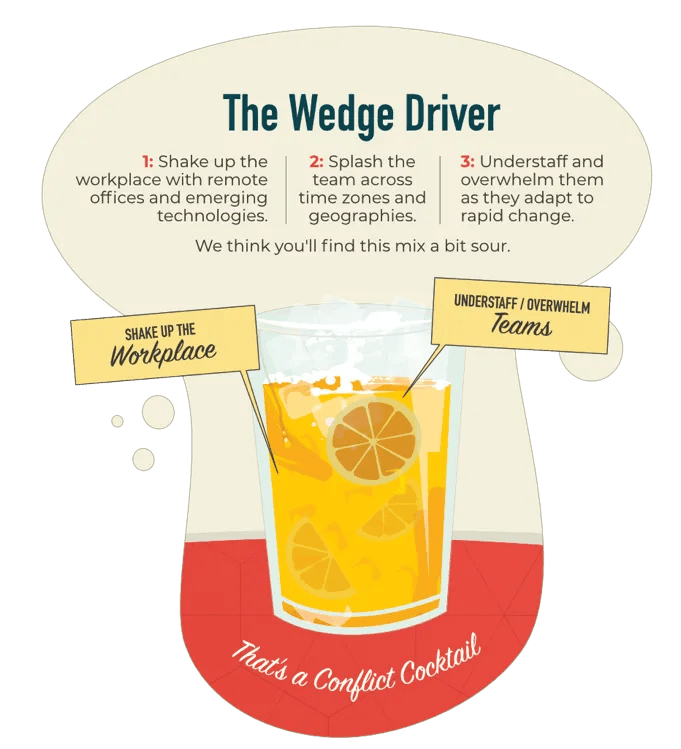Talent Development Leader
Help Your Learning and Development Face Today’s Complex “Conflict Cocktails”
An engaging way to talk about (and address) the complex challenges faced by your learning and development team.
Wed Aug 07 2024

We gathered with leaders at ATD24 in a facilitated networking session to discuss recent research on workplace conflict and to mastermind solutions to their biggest conflicts and challenges. In this article, we’ll share a few of the themes discussed and give you an engaging way to help your L&D leadership team address the complex “conflict cocktails” you face.
Why Conflict Is Getting Worse
In our World Workplace Conflict and Collaboration research, we found that conflict is not only increasing, but it’s getting more complex—what we call “conflict cocktails.”
By “conflict cocktail” we mean a combination of factors that increase the likelihood and intensity of conflict. Various stressors, changes, and challenges combine, creating an environment that’s ripe for conflict.
The move to remote and hybrid teams (many scattered across time zones), post-pandemic stress and mental health challenges, constantly shifting priorities, and new technology topped the list of conflict cocktail ingredients causing trainers and learners to feel more disconnected from their objectives and one another.

The “Conflict Cocktails” Faced by Today’s L&D Leaders
Consistent with our research, some of the biggest challenges these learning leaders discussed centered around clarity and connection. They talked about the challenges of building a shared understanding of success and clear priorities, as well as how hard it was to build deep human connection in asynchronous and remote training.
Here are a few examples of “conflict cocktails” faced by today’s learning leaders and what to do about them.
Let’s start with the Distracted Development Dilemma, which highlights the need for increased clarity and focus.
The Distracted Development Dilemma
Ingredients:
Constant organizational changes
Short-term focus over long-term investment
Competing priorities and budget constraints
Description: The Distracted Development Dilemma captures the struggle of building effective training programs in an environment where rapid organizational changes and a focus on immediate issues overshadow the need for long-term development. Training leaders face resistance to investing in comprehensive training programs due to competing priorities and limited budgets.
Strategies to Address the Distracted Development Dilemma:
Align Training With Immediate Needs: Design training programs that address both short-term challenges and long-term goals. Highlight how immediate skill enhancements and better habits can lead to quick wins for the organization while building a foundation for future success.
Showcase ROI of Training: Use data and case studies to demonstrate the ROI of training programs. Provide concrete examples of how training has led to improved performance, reduced turnover, and increased productivity in similar organizations.
Develop Agile Training Solutions: Create flexible training programs that can quickly adapt to changing organizational needs. Modular training sessions, microlearning, and just-in-time training resources can be more palatable to organizations focused on short-term gains.
Integrate Training into Daily Work: Embed training into everyday work processes to make it more relevant and less of a burden. Use on-the-job training, mentoring, and coaching to integrate learning with practical application.
Pilot Programs and Small Wins: Start with pilot programs to demonstrate success on a smaller scale. Use these wins to build momentum and gain buy-in for larger initiatives.
If you’re faced with the Distracted Development Dilemma, where constant organizational changes, a short-term focus, and limited budgets hinder your efforts to build effective training programs, align your training with immediate needs, showcase the ROI, develop agile solutions, integrate training into daily work, and start with pilot programs.
Next, let’s look at a conflict cocktail caused by lack of human connection.
The Disconnection Daiquiri
Ingredients:
Limited face-to-face interaction
Over-reliance on asynchronous learning
Lack of personal engagement strategies
Description: The Disconnection Daiquiri represents the struggle trainers face when there’s a lack of human connection with their learners. This cocktail is blended from limited face-to-face interactions, an over-reliance on asynchronous learning methods, and insufficient personal engagement strategies. When trainers cannot connect personally with learners, it can lead to disengagement, lower retention of information, and a feeling of isolation among participants.
Strategies to Address the Disconnection Daiquiri:
Increase Synchronous Interactions: Incorporate more live sessions where trainers and learners can interact in real time. Use video calls, live chats, and live online training to create a more interactive learning environment.
Build a Learning Community: Create online forums, discussion boards, and social media groups where learners can connect with each other and with trainers outside of formal training sessions. This fosters a sense of belonging and encourages peer support.
Personalize Learning Experiences: Tailor training content and delivery methods to the individual needs and preferences of learners. Use personalized emails, direct messages, and one-on-one check-ins to show learners that their progress and engagement matter.
Foster Open Communication: Encourage learners to share their thoughts, feedback, and concerns. Create a safe and open environment where learners feel safe to talk about the stress and pressure they feel.
By addressing these challenges with targeted strategies, training and development leaders can transform the Disconnection Daiquiri into a more engaging and connected learning experience.
Another big challenge was trying to navigate a matrix environment. Bring on the Clarity Conundrum Cocktail.
The Clarity Conundrum Cocktail
Ingredients:
Multiple reporting lines and stakeholders
Inconsistent communication channels
Divergent priorities and goals
Description: The Clarity Conundrum Cocktail represents the struggle of operating within a matrix environment where learning and development leaders face confusion due to multiple reporting lines, inconsistent communication, and conflicting priorities. This lack of clarity can hinder the team’s ability to build a shared understanding of success and clear priorities, making it challenging to develop effective training programs and foster deep human connections in asynchronous and remote settings.
Strategies to Address the Clarity Conundrum Cocktail:
Align on Shared Goals: Facilitate workshops or meetings to align on shared objectives and success metrics. Ensure all stakeholders understand and agree on the long-term vision and immediate priorities. Establish clear criteria for who owns what decisions.
Establish Clear Communication Channels: Develop standardized communication protocols to ensure all team members receive consistent information. Utilize collaborative tools that support transparency and regular updates.
Foster Regular Check-ins: Implement regular check-ins and feedback sessions to maintain alignment and address any emerging issues promptly. Use these sessions to re-evaluate goals and adjust strategies as needed.
Promote Asynchronous Collaboration: Encourage the use of asynchronous communication tools to allow team members to contribute and collaborate effectively across different time zones. Provide training on best practices for remote teamwork to enhance connectivity.
If you’re faced with the Clarity Conundrum Cocktail, where multiple reporting lines, inconsistent communication, and divergent priorities create confusion in your learning and development efforts, establish clear communication channels, define roles and responsibilities, align on shared goals, foster regular check-ins, and promote asynchronous collaboration.
Facilitate Your Own “Conflict Cocktail” Mastermind Conversation
You can use a similar “conflict cocktail” exercise with your learning and development leadership team. It’s such a fast and fun way to help your team quickly align on the challenges they’re facing—it’s easier to be creative and curious when you can laugh at (and name) what scares you.
If you’re interested in holding a similar “conflict cocktail mastermind” conversation with your L&D team, you can download the free Collaboration Resource Guide we shared at ATD24 (see pages eight and nine for step-by-step facilitation notes on this exercise).
